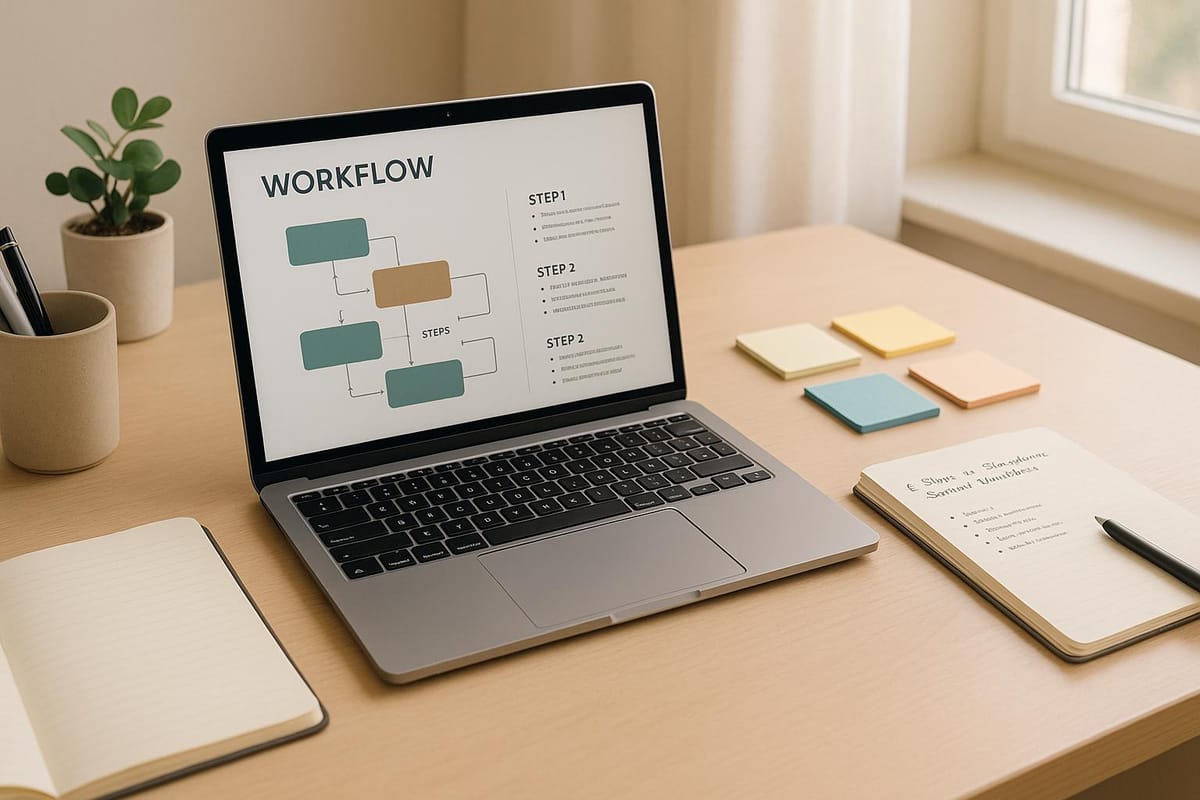5 Steps to Standardize Support Workflows
Standardizing support workflows can enhance response times and service quality. Follow these 5 steps to improve your support processes effectively.

Want faster response times, consistent service quality, and scalable support systems? Standardizing your support workflows is the answer. Here's how to do it in 5 simple steps:
- Identify Key Processes: Focus on high-volume or problematic areas like password resets or billing inquiries. Use analytics to pinpoint bottlenecks.
- Document Current Workflows: Map out processes visually with flowcharts, showing steps, decisions, and handoffs.
- Write Clear Guidelines: Create step-by-step instructions and communication templates for common scenarios.
- Test and Train: Run small-scale tests, gather feedback, and train your team with real-world scenarios.
- Measure and Improve: Track metrics like resolution times and customer satisfaction. Update workflows based on feedback and data.
Quick Overview
| Step | Purpose | Tools to Use |
|---|---|---|
| Select Processes | Focus on impactful areas | Analytics dashboards |
| Document Workflows | Visualize steps and decisions | Flowchart tools |
| Write Guidelines | Ensure clarity and consistency | Templates and guides |
| Test Workflows | Identify and fix issues early | Training sessions |
| Measure & Improve | Adapt to changing needs | Metrics and feedback |
By following these steps, you’ll create efficient, scalable workflows that improve both team performance and customer experience.
Step 1: Select Key Support Processes
Start by pinpointing the support processes that need improvement, prioritizing those that have the greatest impact.
Identify Process Bottlenecks
Look for areas where your support operations hit snags. Common signs include:
- Tickets getting stuck or experiencing delays
- Agents handling similar issues inconsistently
- Frequent escalations to higher support tiers
- Customer feedback highlighting confusion or dissatisfaction
Use tools like HelpJam's analytics dashboard to track important metrics such as resolution times, response delays, and ticket status changes. These insights can help you spot recurring issues.
Focus on High-Volume Processes
Give priority to processes that occur frequently and have a noticeable impact. Here's a quick breakdown:
| Process Type | Impact Areas | Priority Level |
|---|---|---|
| Password Resets | Account security and access | High – a frequent request |
| Billing Inquiries | Revenue and customer retention | High – sensitive financial matters |
| Product Setup | User onboarding and adoption | Medium – essential but less frequent |
| Feature Questions | Product usage and education | Medium – routine but steady |
| Account Changes | Administrative tasks | Low – typically straightforward |
When deciding which processes to tackle, consider these factors:
- Customer Impact: Which processes directly influence customer satisfaction?
- Volume Metrics: How many tickets are tied to each process?
- Resource Usage: How much agent time is being spent on these tasks?
- Complexity Level: Are there multiple steps or varying approaches involved?
Start by standardizing just a few key processes. Use your support platform's analytics to track performance and measure progress. Once you've streamlined these, document the updated workflows to keep things consistent moving forward.
Step 2: Document Current Workflows
Create Flowcharts
Once you've identified key processes, it's time to map them out visually. Use flowcharts to break down every stage of your support workflows. Highlight steps, decisions, and handoffs to get a clear picture of how everything connects:
- Start: When a customer first contacts support or creates a ticket
- Decision Points: Points where actions change based on specific criteria
- Action Steps: Tasks carried out by support agents
- Handoffs: Transfers of tickets between teams or support levels
- Resolution: The final steps to close out the interaction
Here’s a quick guide to essential flowchart elements:
| Element | Purpose | Example |
|---|---|---|
| Process Steps | Outline sequential actions | Ticket creation → Initial response → Investigation |
| Decision Points | Show where paths split | Priority assessment (High/Medium/Low) |
| Team Assignments | Indicate shifts in responsibility | L1 Support → Technical Team → Customer Success |
| Time Estimates | Set expectations for each stage | Initial response: 1 hour, Resolution: 24 hours |
Tools like HelpJam's analytics dashboard can help confirm these workflows by analyzing data on ticket routing, response times, and resolution paths.
Get Team Input
Involve your team to ensure workflows reflect real-world scenarios. Organize feedback sessions to:
-
Capture Process Variations
Understand how teams handle similar issues differently. Pinpoint best practices, areas needing standardization, and successful methods worth documenting. -
Address Challenges
Identify pain points like system limitations, communication breakdowns, redundant steps, or manual workarounds that slow down the process. -
Review Solutions
Take note of effective workarounds, areas that need formalized processes, and common resolution patterns.
Leverage AI-powered tools to analyze support conversations and uncover recurring themes. These insights will help you build clear, actionable support guidelines in the next step.
Step 3: Write Support Guidelines
Create Clear Instructions
Once your workflows are documented, turn them into detailed, step-by-step guidelines. These should remove any uncertainty and help your team deliver consistent service.
Break down complicated tasks into smaller, easy-to-follow steps. For every support scenario, include:
- Conditions that trigger the process
- Key customer details needed
- Specific actions for agents to follow
- Criteria for choosing different response paths
- Timeframes for resolving the issue
- Escalation points and procedures
| Guideline Component | Description | Example |
|---|---|---|
| Process Overview | Summary of the workflow | Password reset assistance |
| Required Information | Data needed to proceed | Account email, security verification |
| Action Steps | Step-by-step instructions | 1. Verify identity, 2. Generate reset link |
| Success Criteria | Signs of successful resolution | Customer confirms access within 24 hours |
| Escalation Points | When to involve other teams | After 3 failed reset attempts |
Once you've outlined these steps, take it further by standardizing communication through templates.
Build Support Templates
Templates ensure consistent, high-quality communication across all support channels. They also save time and improve efficiency.
Create templates for common situations like:
-
Initial Response Templates
These help set the right tone and gather necessary details. Include:- A warm greeting
- Confirmation of the issue
- Next steps to expect
- Estimated resolution time
-
Follow-up Messages
Keep customers updated with templates for progress updates. Include:- A summary of progress so far
- Requests for any additional information
- Next action steps
- Timeline updates
-
Resolution Templates
Use these to wrap up interactions effectively. Include:- A summary of the solution
- Steps for verifying the fix
- Links to helpful resources
- A quick satisfaction survey
Adjust templates based on factors like:
- The complexity of the issue
- Customer type or segment
- Communication channel being used
- How urgent the response needs to be
Store all guidelines and templates in your knowledge base. Use analytics to regularly refine and update them. Once everything is in place, move on to testing these workflows in Step 4.
Step 4: Test New Workflows
Start with Small-Scale Tests
Begin by testing workflows on a smaller scale. This helps identify potential problems early while keeping disruptions to a minimum. Select a diverse sample of cases and team members for these tests. Use tools to track key metrics like resolution times and customer satisfaction. These results will help you fine-tune the process before rolling it out more broadly.
Train Your Support Team
Provide your team with hands-on training that mirrors real-life support situations. Offer clear guidelines and practical exercises, including simulations of support scenarios, to help them get comfortable with templates and escalation processes. Gather feedback during training and conduct quality checks to ensure consistency. Use analytics and team suggestions to improve both the training materials and the workflows before introducing the new system to the entire team.
Step 5: Measure and Improve Results
Track Support Metrics
Keep an eye on key metrics like conversation trends, resolution rates, and response times using a daily dashboard. This helps you quickly spot patterns and address any issues. For example, if your first response time is taking longer than expected, look into what's causing the delay during initial contact.
Tools like HelpJam's analytics can provide real-time tracking and generate reports to assess workflow efficiency. Pay close attention to resolution rates - they often reveal whether your workflows are effectively solving customer problems. Don’t just focus on numbers, though. Feedback from customers can offer valuable insights to fine-tune your processes.
Use Team and Customer Input
Your support team and customers are excellent sources of feedback to improve workflows. Team members can highlight areas where processes feel clunky, while customers can point out pain points from their perspective.
To create a solid feedback loop, consider:
- Holding regular team reviews to evaluate workflow performance
- Reviewing customer satisfaction surveys after support interactions
- Conducting periodic audits with your support team
- Centralizing all suggestions for easy reference
Feedback collection should be ongoing. You can also use AI tools to analyze customer conversations, picking up on recurring issues or patterns that might signal areas needing improvement.
Update When Needed
Use the insights you gather to update workflows as needed. Customer needs and business priorities change, so your workflows should too.
It’s time to make updates when you notice:
- A spike or drop in customer support volume
- New product features or service changes
- The addition of new support channels or technologies
- Changes in team size or structure
When revising workflows, AI tools can help by summarizing interactions and identifying actionable insights. This ensures your updates are based on real data, not guesses, keeping your workflows aligned with actual support trends.
Conclusion: Results of Standard Workflows
Standardized support workflows help teams work more efficiently while improving customer satisfaction. By following clear, structured processes, teams can avoid guesswork and provide consistent, high-quality support in every interaction.
These workflows also deliver measurable results. Real-time analytics can uncover trends in conversations, resolutions, and satisfaction levels, offering actionable insights for ongoing improvements. When paired with HelpJam's tools, such as its unified inbox, AI-driven automation, and real-time analytics, these workflows become even more effective - boosting collaboration, ensuring consistent responses, and tracking performance.
With these processes in place, support teams can achieve:
- Faster response times
- Reliable service quality
- Better team collaboration
- Improvements based on data insights
- Scalable support systems
The real success of standardized workflows depends on regular updates. Adjusting processes based on team feedback and changing customer needs ensures they remain effective as your business grows and evolves. This approach keeps workflows efficient while adapting to new challenges.
FAQs
How can I determine which support workflows need standardization?
To identify which support workflows require standardization, start by reviewing your current processes for inconsistencies. Pay attention to areas where team members handle similar customer issues in different ways, as this can lead to uneven experiences and slower resolution times.
Focus on workflows that frequently cause delays, confusion, or errors. Standardizing these processes can help improve efficiency and ensure a consistent, high-quality experience for your customers. Using a platform like HelpJam, which includes tools like a shared inbox, AI Chatbot, and Knowledge Base, can simplify this process and keep your team aligned.
What are the best practices for documenting support workflows effectively?
Creating clear and effective support workflow documentation is essential for maintaining consistency and efficiency in your customer service operations. Here are a few best practices to consider:
- Use AI tools to streamline processes like summarizing conversations, drafting replies, and proofreading responses, saving time and reducing errors.
- Adopt a unified inbox to manage and organize customer interactions in real-time, ensuring faster response times and efficient resolution.
- Leverage analytics to track performance metrics like response times and resolution rates, helping you identify areas for improvement and optimize operations.
- Incorporate a knowledge base to empower customers with self-service options, reducing the workload on your support team while improving the customer experience.
- Personalize your tools by customizing chatbots and chatboxes to align with your brand and meet specific support needs, creating a seamless and professional experience.
By following these practices, you can create documentation that not only supports your team but also enhances the overall customer experience.
How can I use feedback from my team and customers to improve support workflows?
To enhance your support workflows, actively gather feedback from both your team and customers. Regularly review input from your support team, as they often have unique insights into operational challenges and opportunities for improvement. Similarly, customer feedback can highlight pain points and areas where the process can be streamlined.
With tools like conversation analysis and interaction tracking, you can identify trends and refine workflows to better meet customer needs. Prioritize actionable feedback and implement changes incrementally to ensure smooth adjustments while maintaining efficiency.





